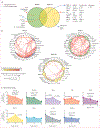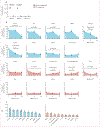Inflammatory profile of patients with tuberculosis with or without HIV-1 co-infection: a prospective cohort study and immunological network analysis
- PMID: 34386782
- PMCID: PMC8357308
- DOI: 10.1016/s2666-5247(21)00037-9
Inflammatory profile of patients with tuberculosis with or without HIV-1 co-infection: a prospective cohort study and immunological network analysis
Abstract
Background: HIV-1 mediated dysregulation of the immune response to tuberculosis and its effect on the response to antitubercular therapy (ATT) is incompletely understood. We aimed to analyse the inflammatory profile of patients with tuberculosis with or without HIV-1 co-infection undergoing ATT, with specific focus on the effect of ART and HIV-1 viraemia in those co-infected with HIV-1.
Methods: In this prospective cohort study and immunological network analysis, a panel of 38 inflammatory markers were measured in the plasma of a prospective patient cohort undergoing ATT at Khayelitsha Site B clinic, Cape Town, South Africa. We recruited patients with sputum Xpert MTB/RIF-positive rifampicin-susceptible pulmonary tuberculosis. Patients were excluded from the primary discovery cohort if they were younger than 18 years, unable to commence ATT for any reason, pregnant, had unknown HIV-1 status, were unable to consent to study participation, were unable to provide baseline sputum samples, had more than three doses of ATT, or were being re-treated for tuberculosis within 6 months of their previous ATT regimen. Plasma samples were collected at baseline (1-5 days after commencing ATT), week 8, and week 20 of ATT. We applied network and multivariate analysis to investigate the dynamic inflammatory profile of these patients in relation to ATT and by HIV status. In addition to the discovery cohort, a validation cohort of patients with HIV-1 admitted to hospital with CD4 counts less than 350 cells per μL and a high clinical suspicion of new tuberculosis were recruited.
Findings: Between March 1, 2013, and July 31, 2014, we assessed a cohort of 129 participants (55 [43%] female and 74 [57%] male, median age 35·1 years [IQR 30·1-43·7]) and 76 were co-infected with HIV-1. HIV-1 status markedly influenced the inflammatory profile regardless of ATT duration. HIV-1 viral load emerged as a major factor driving differential inflammatory marker expression and having a strong effect on correlation profiles observed in the HIV-1 co-infected group. Interleukin (IL)-17A emerged as a key correlate of HIV-1-induced inflammation during HIV-tuberculosis co-infection.
Interpretation: Our findings show the effect of HIV-1 co-infection on the complexity of plasma inflammatory profiles in patients with tuberculosis. Through network analysis we identified IL-17A as an important node in HIV-tuberculosis co-infection, thus implicating this cytokine's capacity to correlate with, and regulate, other inflammatory markers. Further mechanistic studies are required to identify specific IL-17A-related inflammatory pathways mediating immunopathology in HIV-tuberculosis co-infection, which could illuminate targets for future host-directed therapies.
Funding: National Institutes of Health, The Wellcome Trust, UK Research and Innovation, Cancer Research UK, European and Developing Countries Clinical Trials Partnership, and South African Medical Research Council.
Figures




References
-
- WHO. Global Tuberculosis Report. 2020. Geneva: World Health Organization, 2020. https://www.who.int/tb/global-report-2020 (accessed Jan 18, 2021).
Publication types
MeSH terms
Substances
Grants and funding
LinkOut - more resources
Full Text Sources
Medical
Research Materials
